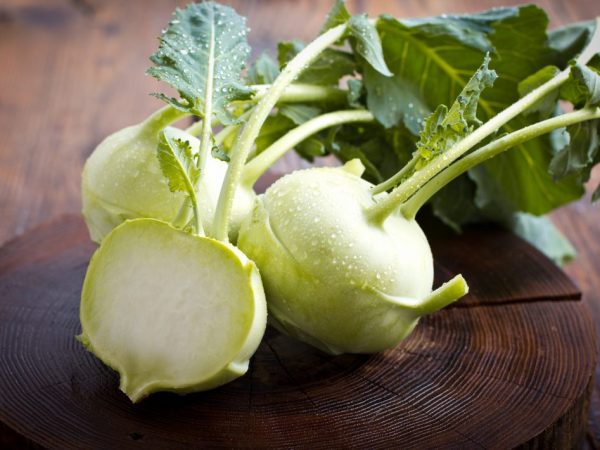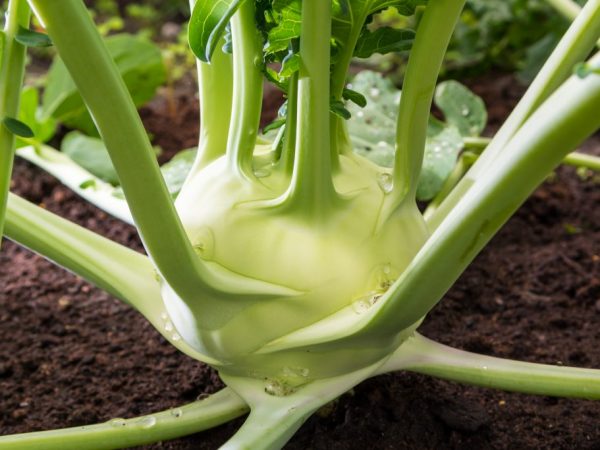The benefits and harms of Kohlrabi cabbage
Despite the fact that Kohlrabi cabbage has been grown for several centuries, it has become popular in our region only in the last few years. Today, this healthy vegetable is used to prepare culinary masterpieces around the world.

The benefits and harms of Kohlrabi cabbage
Vegetable composition
To understand what a vegetable is useful for, you need to know what components are included in its composition. Kohlrabi cabbage contains vitamins A, PP, C, B2. Most of all in the vegetable is vitamin C.
Of the microelements, the composition of a specific vegetable includes calcium, magnesium, potassium, iron, cobalt, phosphorus. If we talk about the percentage ratio of microelements, then most of all in the composition of the vegetable culture of potassium: 100 g of the product includes 0.35 g of this component. 2 times less magnesium and phosphorus in Kohlrabi, other trace elements are present in insignificant quantities.
Improves the palatability of the vegetable fructose and glucose. These natural sugars do not harm the figure, therefore the vegetable culture is recommended for people prone to overweight, and the fiber included in the composition cleanses the body of toxins and toxins.
Also, the vegetable culture contains vegetable protein, which is necessary for the human body, mineral salts, sulfur compounds and folic acid. The energy value of the vegetable is 27 calories per 100 g of product. Few foods are so low in calories. The glycemic index of fresh kohlrabi is 20 units. For comparison, we note that in white cabbage, Brussels sprouts and cauliflower, it is 10-12 units higher.
Thus, the nutritional value of the root crop is unusually high.
Beneficial features
Consider the benefits of Kohlrabi cabbage for the human body. This vegetable crop helps to normalize the digestive tract and gallbladder. It is indicated for people with impaired liver function. Also, its regular use helps to put in order metabolic processes, which helps to get rid of excess weight. The ratio of BJU (proteins, fats and carbohydrates) is optimal.
Kohlrabi cabbage is irreplaceable for people whose body retains water. It has a mild diuretic effect, thereby facilitating the elimination of excess fluid.
The properties of the root vegetable also benefit people with high blood cholesterol levels. Kohlrabi cabbage is indicated for people with diseases of the cardiovascular system. Eating the fruit lowers blood pressure and strengthens the heart muscle. Kohlrabi significantly reduces the risk of atherosclerosis.
Cabbage also has a beneficial effect on the immune system. The vitamins and phytoncides included in its composition do not allow bacteria and viruses that have entered the body to develop.
Kohlrabi cabbage fruits have a beneficial effect on the functioning of the nervous system. Eating a vegetable can help improve mood and reduce anxiety.
Talking about the beneficial properties of kohlrabi cabbage, it should be noted that it reduces the likelihood of rectal cancer. The presence of purine compounds makes the stem fruit useful for people with gout.
Useful properties of cabbage juice
Useful properties are possessed not only by the pulp of a vegetable culture, but also by its juice. This is due to the fact that it contains the same trace elements and vitamins as in the pulp. In folk medicine, juice squeezed from the pulp of a fresh fruit is used to treat colds, vitamin deficiency, asthma and hepatitis.
For the treatment of these diseases, you can use decoctions made from Kohlrabi cabbage. In folk medicine, vegetable juice is also used to prevent scurvy, which appears due to a lack of vitamin C in the body.
Women should freeze some of the beneficial juice and use it for their morning wash. This procedure will help to preserve the youthfulness of the facial skin as long as possible.
You can use any means from Kohlrabi cabbage for the treatment of diseases only after consulting your doctor.
Contraindications

Eat Vegetable With Care
Despite the beneficial properties that a vegetable possesses, it must be consumed wisely, otherwise the body will be harmed.
First of all, you need to make sure that there is no individual intolerance to this vegetable crop. When using it for the first time, you should limit yourself to a small piece.
Doctors do not recommend using Kohlrabi cabbage for people who have increased acidity. Gastritis is also a contraindication to the use of this product. Limiting the use of a healthy vegetable is also worth people who have acute pancreatitis.
Doctors do not recommend eating fresh cabbage for women in position and for nursing mothers.
Kohlrabi varieties
Today there are many varieties of Kohlrabi.
There is no particular difference in taste between different varieties. Some varieties have a richer taste and are suitable for preparing various dishes, while others are less intense and suitable for preservation or long-term storage for the winter. There are hybrids that can be frozen. When choosing a variety, you need to decide on the purpose of using the vegetable.
Kohlrabi tubers, according to the description, can have a shape close to the shape of a ball, or they can be slightly elongated in length or width.
Fruits of different varieties look different: they differ in color. There are red, pink, white-green, purple and violet-blue vegetable crops. But if white cabbage is completely painted in the same color, Kohlrabi is white inside, regardless of the color of the peel.
The most popular today are the following varieties:
- Giant;
- Madonna;
- Vienna White 1350;
- Gulliver;
- Cook;
- Terek F1;
- Blue Planet;
- Corist F1;
- Nessie;
- Delicacy white;
- Gusto;
- Violet.
When choosing a variety, they pay attention not only to the names, which in most cases reflect the peculiarity of a particular hybrid, but also to the characteristics indicated on the package.
Recommendations for growing vegetables
An overseas vegetable is a modified shoot, in which the stem thickens strongly in one part. This is exactly the definition of this cabbage variety that is given in his Ozhegov dictionary.

Cabbage is very easy to care for
Kohlrabi looks like a turnip. She is not afraid of frost and loves moisture, although, thanks to the powerful root system (the roots of the plant go into the ground by 1.5-2 m), Kohlrabi is doing well with the lack of sufficient water and other stressful situations. The plant needs minimal care, which boils down to timely watering and loosening the soil. White cabbage, red cabbage and cauliflower are more demanding in their care.
Kohlrabi should be planted after legumes, potatoes, beets, tomatoes or cucumbers.Pepper is a good predecessor for this vegetable crop. Turnips, turnips, lettuce, watercress, radishes and rutabagas are not the best predecessors of this vegetable crop.
During the ripening of the plant, it is important to apply fertilizers; in the fight against diseases and pests, chemicals must be applied with caution: delicate fruits are sensitive to chemicals. With the wrong dosage of the drug, it is easy to cause a chemical burn to the plant. During chemical burns, spots and yellow stripes appear on the leaves and roots.
Variety selection
When choosing varieties, pay attention to the color of the peel. White-colored vegetables ripen faster than purple-blue colored vegetables. The former are intended for early harvest, unsuitable for storage. Mid and late ripening varieties can usually be stored for a long period of time. In white varieties, the aboveground fruit is the most delicate, but it thickens quickly, so it is important to harvest an early harvest on time.
When buying seeds, pay attention to the manufacturer's recommendations regarding the growing region. Vegetable crops grow even in regions with cold climates, but when grown in northern regions, the appropriate variety is chosen.
At the dacha, film covers or small greenhouses are installed. It is preferable to grow any kind of vegetable in the middle lane, where the climate is milder. When growing Kohlrabi in the middle lane, seeds can be planted in open ground.
To get a good harvest, seeds are bought only in specialized stores. Choose varieties intended for cultivation in a specific region.
Cleaning and storage of vegetables
Both turnips and Kohlrabi must be harvested just in time. A ripe root crop that has stood in the garden cracks, loses its taste and becomes tough.
The crop ripens together, so it is convenient to harvest it. The size of the ripened tubers is about 8 cm. The exception is giant varieties, the diameter of the fruit of which is 10 cm or more. It is important to have time to harvest late-ripening varieties before the first frost occurs.
After harvesting, the harvest is prepared for storage for the winter. For this, the leaves and root are removed. Together with the leaves, the stems are cut, leaving stalks 2-4 cm long, then the roots are put in wooden boxes, sprinkling each layer with dry and clean sand, and sent to the cellar, where it is best to store them in winter. If there is no cellar, you can use the garage, after wrapping the boxes with a warm blanket.
Eating root vegetables
Stems and leaves are not edible. You can only eat stalkblood. A variety of dishes are prepared from a specific and unusually tasty root vegetable, but fresh Kohlrabi cabbage is most useful for health, so you need to choose recipes that do not imply long-term heat treatment of the stem.
Kohlrabi is good stewed and fried, you can also grill it. Chefs serve Estonian and soy sauces to the vegetable, which emphasize its taste.
You can serve vegetable stews containing kohlrabi with chicken, fish and shrimp dishes. You can fry the tubers in batter or make pancakes. For salads, it is best to use olive oil and lime juice.
Summarizing
It is easy to answer the question of whether Kohlrabi cabbage is good for you. Just look at the amount of vitamins and minerals in a crop and how it is used.


